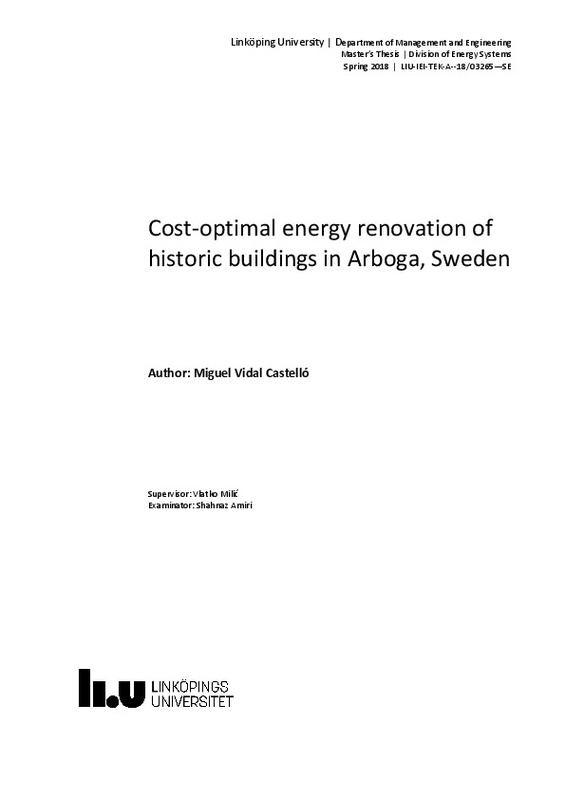JavaScript is disabled for your browser. Some features of this site may not work without it.
Buscar en RiuNet
Listar
Mi cuenta
Estadísticas
Ayuda RiuNet
Admin. UPV
Cost-optimal energy renovation of historic buildings in Arboga, Sweden
Mostrar el registro sencillo del ítem
Ficheros en el ítem
| dc.contributor.advisor | Montalva Subirats, José Miguel
|
es_ES |
| dc.contributor.author | Vidal Castelló, Miguel
|
es_ES |
| dc.date.accessioned | 2020-05-19T06:56:12Z | |
| dc.date.available | 2020-05-19T06:56:12Z | |
| dc.date.created | 2018-09-19 | |
| dc.date.issued | 2020-05-19 | es_ES |
| dc.identifier.uri | http://hdl.handle.net/10251/143660 | |
| dc.description.abstract | [ES] En Suecia, el 27% de las emisiones de CO2 provienen del sector residencial. Un tercio del parque de edificios se construyó antes de 1945. Esto implica un alto potencial de reducción del uso de energía. La optimización LCC es un paso clave en la renovación energética de edificios históricos. En esta tesis, se han llevado a cabo optimizaciones basadas en diferentes objetivos para cuatro categorías de edificios que representan el stock de edificios históricos en Arboga, Suecia. Los otros objetivos de energía incluyen una disminución en el uso de energía en: 10%, 20%, 30%, 40%, 50%, 60% y 70%, así como el óptimo de LCC. Además, se investigan los efectos ambientales de la renovación energética en términos de CO2 equivalente. Los resultados muestran que la bomba de calor de agua subterránea es el sistema de calefacción óptimo en 27 de 28 casos. Además, se concluye que la impermeabilización, junto con el aislamiento del suelo y el techo son rentables en LCC óptima. La reducción de LCC en LCC óptima corresponde a una disminución de, 30%, 30%, 46% y 26% para la categoría 1-4, respectivamente. De esto, se puede concluir que la rentabilidad de la renovación energética en la categoría 3 es la más rentable en términos de disminución porcentual. Además, los resultados indican que la renovación energética es rentable para cada objetivo de energía para el edificio de piedra, categoría 3. Esto es contrario a los edificios de madera, categorías 1, 2 y 4, donde el objetivo del 70% no es rentable desde una perspectiva económica en comparación con antes de la renovación energética. Después de la renovación, las emisiones de CO2 de los edificios se han reducido, obteniendo un ahorro superior al 70% de CO2 equivalente por MWh. | es_ES |
| dc.description.abstract | [EN] In Sweden, 27% of the CO2 emissions are originated from the residential sector. A third of the building stock has been built before 1945. This implies a high potential of energy use reduction. LCC optimization is a key step in the energetic renovation of historic buildings. In this thesis, optimizations based on different targets have been carried out for four building categories representing the historic building stock in Arboga, Sweden. The other energy targets includes a decrease in energy use by: 10%, 20%, 30%, 40%, 50%, 60% and 70%, as well as LCC optimum. In addition, the environmental effects from energy renovation in terms of CO2 equivalent is investigated. The results shows that the groundwater heat pump is the cost-optimal heating system in 27 of 28 cases. Furthermore, it is concluded that weather-stripping, together with floor and roof insulation are cost-effective at LCC optimum. The reduction in LCC at LCC optimum corresponds to a decrease by, 30%, 30%, 46% and 26% for category 1-4, respectively. From this, it can be concluded that the profitability of energy renovation in category 3 is the most profitable one in terms of percentage decrease. Moreover, the results state that energy renovation is profitable for every energy target for the stone building, category 3. This is in contrary with the wood buildings, categories 1, 2 and 4, where the 70% target is not profitable from an economical perspective compared to before energy renovation. After renovation, CO2 emissions from the buildings have been reduced, obtaining saving higher than 70% of CO2 equivalent per MWh. | es_ES |
| dc.language | Inglés | es_ES |
| dc.publisher | Universitat Politècnica de València | es_ES |
| dc.rights | Reserva de todos los derechos | es_ES |
| dc.subject | Energía | es_ES |
| dc.subject | Ciclo de vida óptimo | es_ES |
| dc.subject | Eficiencia energética | es_ES |
| dc.subject | Suecia | es_ES |
| dc.subject | Energy renovation | es_ES |
| dc.subject | Life cicle cost | es_ES |
| dc.subject | LCC | es_ES |
| dc.subject | Energy efficiency | es_ES |
| dc.subject | Sweden | es_ES |
| dc.subject.classification | INGENIERIA DE LA CONSTRUCCION | es_ES |
| dc.subject.other | Máster Universitario en Ingeniería Industrial-Màster Universitari en Enginyeria Industrial | es_ES |
| dc.title | Cost-optimal energy renovation of historic buildings in Arboga, Sweden | es_ES |
| dc.title.alternative | Renovación energética óptima de edificios históricos en Arboga, Suecia | es_ES |
| dc.type | Tesis de máster | es_ES |
| dc.rights.accessRights | Abierto | es_ES |
| dc.contributor.affiliation | Universitat Politècnica de València. Departamento de Ingeniería de la Construcción y de Proyectos de Ingeniería Civil - Departament d'Enginyeria de la Construcció i de Projectes d'Enginyeria Civil | es_ES |
| dc.contributor.affiliation | Universitat Politècnica de València. Escuela Técnica Superior de Ingenieros Industriales - Escola Tècnica Superior d'Enginyers Industrials | es_ES |
| dc.description.bibliographicCitation | Vidal Castelló, M. (2018). Cost-optimal energy renovation of historic buildings in Arboga, Sweden. http://hdl.handle.net/10251/143660 | es_ES |
| dc.description.accrualMethod | TFGM | es_ES |
| dc.relation.pasarela | TFGM\97219 | es_ES |
Este ítem aparece en la(s) siguiente(s) colección(ones)
-
ETSII - Trabajos académicos [10404]
Escuela Técnica Superior de Ingenieros Industriales






